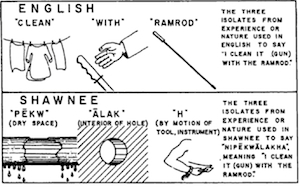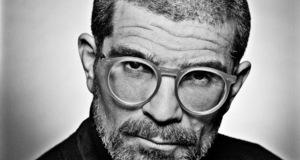Between Linguistic Universalism and Linguistic Relativism: Perspectives on Human Understandings of Reality
By
2013, Vol. 5 No. 09 | pg. 1/2 | »
KEYWORDS:
The most striking feature of language seems to be its diversity: contrary to the rather limited physical variations of the human species, there are 6,909 known languages worldwide – none of which are identical in sound, syntax, lexicon or grammar (statistic from Lewis 2009). This fact raises interesting questions about human understandings of reality: is it innate and universal, shared by all despite ‘surface’ differences in expression, or relative to the language one speaks? This essay begins with a discussion of linguistic structuralism and refutes its central claim, which finds its roots in the semiology of Saussure, that a fixed, universal language structure exists. Next, Barthes’ post-structuralist theory is presented as a possible alternative to linguistic structuralism. It is dismissed, however, because of its problematic, relativist implications. Finally, misconceptions concerning the theses of Boas, Sapir and Whorf are rectified: their linguistic relativity principle should be seen as linguistic pluralism rather than determinism. This will allows us to conclude that the most important critiques of linguistic relativity are based on misinterpretations of the theory, and that recognition hereof is important, as the principles of Sapir, Whorf and Boas provide us with a much better and more complex understanding of human conceptuality than the opposing theories of structuralism and post-structuralism. Structuralism, which at the start of Europe’s Great Age of Theory was viewed as a useful way of sorting human experience by describing larger social structures, is flawed in the very presupposition on which it is built, namely that a fixed and universal structure applicable to all cultural systems exists. In a general sense, structuralism is the practice of studying a large range of phenomena – societies, minds, literature, language, and so on – as systems of connected wholes (that is, structures) based on the idea that the structures of these things affect the way they function (Jackson 1991: 20). It is based on the premise that the way in which humans understand reality is a consequence or a side-effect of the structures studied by such disciplines as anthropology, philosophy and psychoanalysis (Ibid: 9). Linguistic structuralism, the school relevant to the topic of this essay, may therefore be said to study the structure underlying language in an attempt to understand our experience of reality. Characteristic of structuralists is the belief in universal structures upon which all human subjectivity is dependent. This implies that those concerned with linguistics aim to uncover the general conditions which must apply to the grammar of all human languages. In the words of Chomsky, “the existence of innate mental structure is … not a matter of controversy; what we may question is just what it is and to what extent it is specific to language” (1976a, cited in Schaff 1976: 14). It is, however, precisely this existence of an innate and universal mental structure, the presupposition of which forms the basis of all subsequent linguistic structuralism, that is disagreed with here. In order to explain this, a discussion of Saussure’s semiology is needed first, as his work has been the starting point for linguistic structuralists. Semiology is based on the premise that the meaning of human actions and objects must be generated, consciously or unconsciously, by an underlying system of distinctions and conventions (Culler 1983: 72). When applied to the field of linguistic study, this means that the way in which we use language, the simple acts of speaking, reading and writing, must be the result of an underlying structure of rules that define the culturally orthodox way of using language – in other words, rules that define what can be said in a given language and how. Saussure dubbed the activity of using language parole, and the underlying, prescriptive structure langue (Jackson 1991: 41). Langue is in effect an overarching structure of a system of signs, a sign being the unification of a sound or image (the signifier) and the concept to which the signifier refers (the signified, ibid: 48). The link between a signifier and a signified is arbitrary; there is no necessary connection between the two, but once a sound becomes the signifier in a given language, speakers of that language have no option but to relate to them in that way (Holdcroft 1991: 53). As a langue consists of all these arbitrary yet fixed linkages, it is a constraining structure: we are not free to change it. Indeed, Roland Barthes, at one point a self-proclaimed structuralist, said: “The individual cannot himself either create or modify [la langue]; it is a collective constraint which one must accept in its entirety if one wishes to communicate” (1984, cited in Allen 2012: 9).This, it is argued here, is untrue for three reasons. Firstly, if a langue is at once social (in that it is the “possession” of a community of speakers) and fixed, it presupposes a uniform speech-community with a common linguistic resource (Jackson 1991: 42). Yet even within a community there are different linguistic structures to which different social values are attached, linked to affiliations of race and class (Ibid: 43). An example is the language used by many young people on the streets of Rotterdam and Amsterdam in the Netherlands: a complicated mix of Papiamento and Cape Verdean Creole that hardly resembles Dutch grammar, syntax or vocabulary. Even if, for the sake of argument, we suppose that the differences between Papiamento, Creole and Dutch are merely variations on the surface of a more deep-rooted, universal grammatical structure, a second problem of semiology remains: the implied rigidity of language, in complete disregard of historical change or social, cultural and political contexts. A brief look at history shows that on the contrary, language is highly vulnerable to change. These changes range from adjustments in signifier to denote a concept (who, for instance, still says ‘jollux’ to refer to someone who is overweight?) to more fundamental alterations in signifieds, which in turn change human understanding of reality at least in relation to the changed concept. The former does not only disprove the inflexibility of language, but also draws attention to a third problem: the semiological claim that humans are eliminated from the process of arbitrary sign creation. If enough people choose to use the sounds ‘overweight’ and ‘fat’, it is only a matter of time before these replace ‘jollux’ as a signifier, and if enough people started re-using it again, it could theoretically make a come-back. Similarly, especially in today’s world filled with constant technological innovations, new and existing signifiers are coined for new phenomena constantly, and they tend to be incorporated quickly into everyday speech. Most of these are not arbitrary or random: an example is the word ‘web’, an intricate structure suggestive of something woven, to refer to the global network of computers. The claim that the relation between signifier and signified is arbitrary also excludes other cases in which some worldly observation makes a particular sound appropriate for a particular concept. Think of onomatopoeic words related to collisions – bang, click, thump – or a noun such as ‘cuckoo’, which is clearly related to the sound that is made by the signifying concept (Holdcroft 1991: 54). In short, the main claims of semiology, namely that our way of using language is determined by a collective, fixed structure which is arbitrary and from which human choice is eliminated does not hold up in practice: we have shown that it is neither collective, nor fixed, nor free of human interference. This has grave consequences for linguistic structuralists, whose central assumption derives from Saussure’s framework. If semiological theory held up, the structuralist framework based on it would have had serious ramifications on how we see ourselves: our subjectivity would be the result of inevitable insertion into an unconscious system of mental representations; an objective world “outside mental representations of it” would not exist; and our societies would be determined by the way the underlying system processes social behaviour (Jackson 1991: 89-90). However, with a foundation as problematic as that of linguistic structuralism, it is more useful to look elsewhere for an understanding of human conceptuality. Barthes seems to pose an alternative, but as we shall see, his theory is not without problems either. He is often said to be the embodiment of the shift from structuralism to post-structuralism; as linguist Jackson points out, “the term ‘post-structuralist’ has no uniform sense, but it must apply at least to Barthes, who once called himself a structuralist and [then] moved beyond that” (1991: 10). Language, Barthes thought, could be used as a way of analysing cultural artefacts (Culler 1983: 78). In doing so, he came to two conclusions that separated him from previous structuralists (including his previous self): the signs which construct our language are themselves constructed by a larger sign system, and the relation between signifier and signified is therefore not fixed. Barthes recognised a second-order semiological system, in which a sign (that is, the combination of any kind of representation and a corresponding concept) from the first-order system becomes only a signifier in the second. This second-order system is a ‘metalanguage’ in which one speaks about the first language (Barthes 1972 [2009]: 138). Let us illustrate this with an example. Not long ago, The Economist had on its cover an old-fashioned time-bomb detonator attached to some baguettes that were tied together with the tricolore. Here, the signifier is the illustration on the cover; the signified is the bread meant to resemble a time-bomb. Combined, this sign becomes a new signifier – the new signified, however, depends on your knowledge of current affairs, cultural context, political background and so on. While The Economist tried to convey their belief that France’s economy is at the verge of severe decline, most likely with serious consequences for the rest of the Eurozone, a Frenchman might have seen it as just another case of French-bashing by the English. To Barthes, this second-order signified was a myth, used mostly by the bourgeoisie “to make their own ideological view of the world seem like a natural fact; to naturalise a particular kind of class culture” (Jackson 1991: 126-7). In works such as Mythologies, Barthes tried to undermine these myths: wrestling matches, soap-powders, toys, wine and milk – they were all cultural constructs (1972 [2009]). The most radical difference with traditional structuralism is, of course, that the way in which we understand reality is not a pre-existing constraint; rather, it is the indeterminate product of interpretation (Jackson 1991: 14). Language makes allusions to another, ‘higher’ language and partly has to be understood in terms of it. He abandons the idea of a fixed relation between the signifier and signified. He does not, however, simply acknowledge that this relationship can change; he argues that the signifier is always floating, slipping from one use to another. The chain of signifiers is endless, and they do not always lead to the same signified. Herein lies the problem: there is no language-independent meaning, no absolute truth. In this sense, myths create worlds rather than refer to them, since there is no objective world outside of the myth and no world to refer to independent of the myth. He rejects the fixed perspective of structuralism, but in his post-structuralism there is no perspective whatsoever from which to begin to understand human conceptuality. It seems that by going from one extreme (fixed meanings free of human influence) to another (endless meanings based on human interpretation), Barthes reaches a similarly unrealistic conclusion as linguistic structuralism.Continued on Next Page » Suggested Reading from Inquiries Journal
Inquiries Journal provides undergraduate and graduate students around the world a platform for the wide dissemination of academic work over a range of core disciplines. Representing the work of students from hundreds of institutions around the globe, Inquiries Journal's large database of academic articles is completely free. Learn more | Blog | Submit Latest in Linguistics |



















